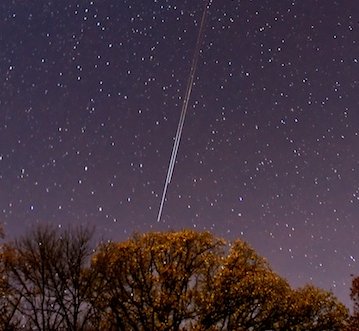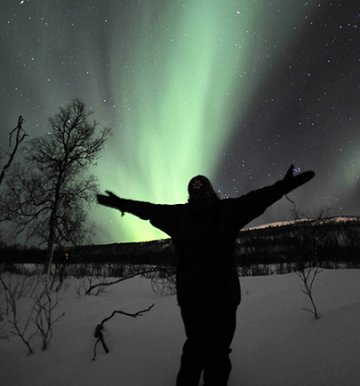NEW AND IMPROVED: Turn your iPhone or iPod into a field-tested global satellite tracker. The Satellite Flybys app now works in all countries. | | | KILLER SUNDOG: In case you missed it last week, here it is again. On Feb. 11th, NASA's Solar Dynamics Observatory flew through a sundog and destroyed it. Hundreds of onlookers at the Kennedy Space Center witnessed the event and a few of them made video recordings. Watch the movies in today's story from Science@NASA. DOUBLE FLYBY ALERT: Space shuttle Endeavour's two-week mission to the ISS is almost finished. The two spaceships are scheduled to undock tonight, Feb. 19th, at 7:54 p.m. EST. This is good news for sky watchers, because there's nothing prettier than two bright spaceships traveling side-by-side through the night sky: 
Ethan Tweedie of Pottsboro, Texas, took this picture on Nov. 25, 2009, shortly after space shuttle Atlantis had undocked from the ISS--the same position Endeavour will be in tonight. "It was quite a sight!" he recalls. Double flybys will continue through Sunday, Feb. 21st when Endeavour returns to Earth in a rare nighttime landing at Kennedy Space Center (10:16 p.m. EST). Check the Simple Satellite Tracker to see if you are favored with an apparition. EXTRA! GLOBAL FLYBYS: Our Satellite Flybys app for the iPhone and iPod Touch has gone global. It now works in every country on Earth. Check it out. NORTHERN LIGHTS: A solar wind stream is buffeting Earth's magnetic field and stirring up auroras around the Arctic Circle. "Last night, the entire sky was filled with fast moving bands and curtains," reports Fredrik Broms of Kvaløya, Norway. He snapped this picture of "one very happy sky watcher": 
"I am amazed at the amount of activity we've been getting this week," Broms adds. "Normally the auroras come and fade, but now it's like someone is constantly feeding a fire." Indeed, for polar aurora watchers, Feb. 2010 has been the best month in quite some time. It's a sign that the sun is coming back to life after a long, deep solar minimum. Sunspots have returned crackling with solar flares, and coronal mass ejections (CMEs) are once again buffeting Earth's magnetic field. NOAA forecasters estimate a 25% to 30% chance of more geomagnetic activity tonight. UPDATED: February Northern Lights Gallery
[previous Februarys: 2009, 2008, 2007, 2006, 2004, 2003, 2002] | 
